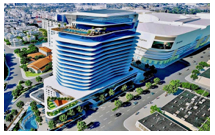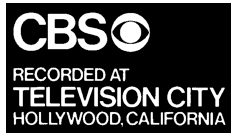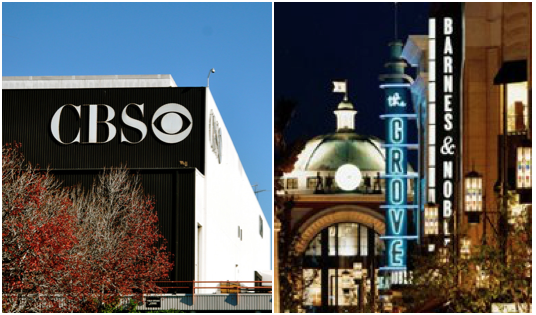CommentsPLATKIN ON PLANNING: Since recent newspaper reports broke about the likely sale of CBS studios, located at the intersection of Beverly and Fairfax since 1950, words have been flying fast and furiously about the future of this site.
Real estate blogs, like LA Curbed and LAist, first published the story in September 2017, reporting that at least two major developers have been contacted, including Rick Caruso, operator of The Grove. Later, the former Councilmember for this area, Zev Yaroslavky, weighed in through a Los Angeles Times guest column. He argued that CBS studios should be preserved as a historic site. In his view this would preserve jobs in the entertainment industry and slow down real estate speculation in the Beverly Fairfax area, a continuous feature since his tenure on the Los Angeles City Council, from 1975 to 1994.
The former Councilmember’s article was met with volleys of criticism from regiments of millennial free-marketeers. They view every twist and turn in Los Angeles as an excuse for private investors and developers to build more market housing. For them, issues of demand, zoning ordinances, adopted plans, and environmental impacts are of little consequence. Ever ready to fling spears and carry water for real estate investors large and small, they tarred Mr. Yaroslavsky with their patrons’ favorite epithet, “NIMBY.“ Like their sponsors, they are oblivious to the former Councilmember’s support for most of the major real estate projects on the west side Los Angeles.
Undeterred by actual facts, these protégés also berated Mr. Yaroslavsky for co-sponsoring Proposition U, ignorant of its actual content. Victorious at the ballot box, this 1986 initiative only stopped some real estate projects with a Floor Area Ratio above 1.5, a new restriction that did not then apply to any real estate projects. Now, 30 years later, this voter initiative only stands in the way of several high-end projects, such as the proposed Caruso luxury high rise tower, a mile to the west of CBS.
When we look at this mini-debate, several important voices are missing.
 Real Estate Investors: There is no doubt many large real estate developers would love to lease or buy this amazingly well-located 25 acre site. It is adjacent to The Grove and the Farmers Market, close to the Pacific Design Center, Beverly Center, Beverly Connection, Cedars-Sinai Hospital, LACMA, Park LaBrea, and in walking distance of pedestrian corridors on Third Street, Beverly Boulevard, Fairfax Avenue, Melrose Avenue, and Santa Monica Boulevard.
Real Estate Investors: There is no doubt many large real estate developers would love to lease or buy this amazingly well-located 25 acre site. It is adjacent to The Grove and the Farmers Market, close to the Pacific Design Center, Beverly Center, Beverly Connection, Cedars-Sinai Hospital, LACMA, Park LaBrea, and in walking distance of pedestrian corridors on Third Street, Beverly Boulevard, Fairfax Avenue, Melrose Avenue, and Santa Monica Boulevard.
When we eventually hear from these developers, Mr. Yaroslavky thinks we will learn about grandiose schemes that the City of Los Angeles cannot possibly approve as by-right projects. Even though the parcel’s C2-1 zoning allows a full range of land uses unrestricted by height limitations, he thinks their inspiration will be Century City. With cash pouring into Los Angeles real estate from the entire planet, their 21st Century dream castles would far exceed existing zoning, adopted plan designations, and available infrastructure and public services.
Local residents: We have also heard little from nearby residents, including the many homeless people living on local streets and in nearby encampments, despite the vast amount of new market housing available in the Fairfax area. After all, this area has been a center of gentrification for nearly four decades. It addition to at least 200 plus big, boxy McMansions in nearby Beverly Grove, the Casden company’s enormous Palazzo apartment complex on Third Street, and many new market rate apartment buildings on the Miracle Mile, homelessness has shot up in Fairfax area, like everywhere else in Los Angeles.
 Near the CBS site, there is no shortage of available old and new apartments, condos, and houses for those who need a place to live. All they need is $3000 per month for a local one or two bedroom apartment, $700,000 to buy an average condo in the neighborhood, or $2 to 4 million for a new McMansion, just sitting empty, ready for a quick move-in.
Near the CBS site, there is no shortage of available old and new apartments, condos, and houses for those who need a place to live. All they need is $3000 per month for a local one or two bedroom apartment, $700,000 to buy an average condo in the neighborhood, or $2 to 4 million for a new McMansion, just sitting empty, ready for a quick move-in.
Planning Issues: Kudos for the former Councilmember for raising critical planning issues affecting the CBS sale, but there is much more to this story. The most important chapter is the original MetroRail alignment, which in 1983 went north from Wilshire on Fairfax Avenue, connecting the proposed Miracle Mile station at Wilshire and Fairfax to West Hollywood. From there the subway double-backed on itself to reach the San Fernando Valley via the Cahuenga Pass. Totally attuned to local sentiment, the Southern California Rapid Transit District (SCRTD) – now called METRO -- sponsored a series of community milestone meetings at every station on the proposed alignment, including the Beverly Fairfax neighborhood. In response to these community planning meetings, the SCRTD issued many Milestone Reports, several of which are still available on-line.
The SCRTD also commissioned the Los Angeles Department of City Planning to prepare detailed Specific Plans for all 13 proposed Metrorail stations, including a station at the corner of Beverly and Fairfax, which encroached on the CBS site. The resulting Fairfax-Beverly Specific Plan assumed extensive rebuilding of the entire area, including CBS, the Farmers Market, and adjacent parcels now part of The Grove. The draft Specific Plan, which advanced as far as the Los Angeles City Planning Commission, was supported by a full Draft Environmental Impact Statement.
It also capped future real estate development in the Specific Plan area to three escalating levels of transportation capacity:
- Level 1 - Existing transportation capacity.
- Level 2 - Existing capacity enhanced by such TDM and TSM features as timed lights and ridesharing.
- Level 3 - A completed MetroRail subway, with a station at Beverly and Fairfax.
For both good and bad reasons the SCRTD dropped this alignment, switching to the Vermont Corridor. The Department of City Planning, undoubtedly with the blessing of local City Council members, then abandoned the 13 Specific Plans, including the completed plan for the Beverly- Fairfax area. Remarkably, the major property owners for this large area, CBS and the Gilmore Company, then hired renowned Bay Area architect, Barry Elbasani to develop a post-Metro Rail master plan for the combined CBS/Farmers Market site. As part of his comprehensive planning process, Mr. Elbasani held extensive community outreach meetings with nearby residents and businesses. His efforts, however, floundered because of the recession in the 1980s, and in 1986 CBS pulled the plug on his master plan.
But, when the next real estate boom began in the 1990s, new development plans re-emerged, but without the Beverly Fairfax Specific Plan and without Barry Elbasani’s extensive community planning efforts. Having round-filed his work, CBS studios only change was to pave over its vast and well-maintained lawn with acres of parking lots. This, ironically, was also the intended location for the MetroRail subway station.
As for the Farmers Market and its adjacent properties, the Gilmore Company tapped Rick Caruso to develop a new shopping center. The result was a downsized Farmers Market and a large, regional shopping center, The Grove. From a financial perspective, The Grove is a ringing success. As for traffic and urban design, it is a colossal failure. It is a landlocked, inward-facing, Disneyesque regional shopping center at least a mile from a future subway station. If METRO sticks to its construction schedule, the Purple Line Extension will begin operations in 2023, 21 years after The Grove opened for business. Even then, it is doubtful that more than a trickle of Grove customers will rely on the subway for their shopping and entertainment.
In the pell-mell efforts to obtain multiple zoning waivers to build The Grove, the prior public and private planning efforts for this location were ignored, presumably because they would have mandated a smaller shopping center. They stood in the way of “progress,” as measured by the price per square foot for construction and leasing, not in community-serving uses, pedestrian access, street capacity, traffic congestion, or reduced air quality.
We also need to mention the Wilshire Community Plan, part of the Los Angeles General Plan Land Use Element. The City Council adopted this plan in 2001, a year before The Grove opened its doors. Had the City Planning Department, City Planning Commission, and City Council adhered to their official policy document, they never would have approved a regional shopping center for this location. But, they did, and the former Councilmember, Zev Yaroslavky, who was the sole City Council vote against The Grove, must know this. He is also correct when he predicts that any developer who acquires this property will propose another inappropriately located regional center, perhaps an expansion of The Grove.
The Local Neighborhood Context: The nearby Beverly Grove neighborhood is, according to the Los Angeles Times, a center of gentrification and evictions in Los Angeles, most initiated by Wiseman Residential. According to the newspaper, this company specializes in buying smaller apartment buildings, many near the CBS site, evicting tenants through the Ellis Act, demolishing the emptied buildings, and then building new, expensive apartment structures on the cleared parcels. The Times attributes 237 evictions to Wiseman Residential, but in the areas near the CBS site, where I live, I think the real displacement figures are much higher. For example, mansionizers have bulldozed over 200 local houses in the past decade. The replacement houses are much larger and more expensive, even though the number of residents remains the same.
Plus, there are many other local Wiseman projects in which the company used cash-and-key scams to get rid of existing tenants without the Ellis Act, so, technically, these local residents were not evicted. Plus, other real estate companies are getting into the act, with a number of SB 1818 projects now appearing. This is yet another gimmick that allows developers to exceed zoning limitations by promising to make 5 to 10 percent of their units affordable. Without any on-site City of L.A. inspections, though, it is impossible to know if recent evictees or the local homeless have finally found a way to move indoors, off of local streets or out of their cars.
Furthermore, immediately north of the CBS site, there there are many blocks of historic Spanish style four-plexes, most dating from the late 1920s. A long-stable neighborhood of Jewish immigrants, students, young couples, and entertainment industry employees, the mansionizers are also beginning to tear down these historic structures. Local property owners and tenants, though, are pushing back through the Save Beverly Fairfax organization. They are working hard to establish a Historical Preservation Overlay Zone (HPOZ) for their area. If successful, it would become the sixth HPOZ in this part of L.A., all efforts to push back against the same real estate speculation that could easily swamp them at the CBS site.
Same Housing Crisis: Despite an abundance of old and new rental housing in the Fairfax area, it suffers from the exact same housing crisis as nearly every other neighborhood in Los Angeles. If the CBS site augments local McMansions and Wiseman apartment houses with multiple high-rise, high-rent residential towers, it will still not alleviate the long-term housing and infrastructure crisis of the Fairfax area. It will actually aggravate it. The local streets will become even more clogged since few of the new tenants will ride local METRO buses or, after 2023, stroll a mile down Fairfax Avenue to take the Purple Line subway to Koreatown or Downtown L.A. Likewise, to cite only a few examples, the local water mains will more frequently erupt into geysers, and the number of electrical brown and black outs will increase. Likewise, the nearby Hancock Park elementary school, Fairfax High School, and Pan Pacific Park Rec Center will need to pack more kids into the same space, on the same budget.
As for local rents and housing prices, the Fairfax area of Los Angeles is already a living case study demonstrating that new expensive rents pull up existing, lower-priced rents. Despite the free market doctrines of the supply-and-demand, build-more-housing preachers, over-priced apartment do not reduce local rents, even when new units go begging for tenants. Instead, landlords just resort to AirBnB and other short-term rentals, without ever looking back. According to Inside AirBnB, Los Angeles apartment owners can get a full years rent in two to three months through AirBnB. Once they do this, the game is over. Furthermore, other landlords quickly catch on, realizing the hassle of short-term rentals is more than worth it financially. This get rich quick scheme does not solve L.A.’s housing crisis; it makes it worse.
All of this planning contextual information needs to be carefully considered when the City of Los Angeles reviews impending discretionary actions for the CBS site. Considering the ominous precedents of jettisoning the Beverly-Fairfax Specific Plan and the Barry Elbasani master plan, as well as the City Council’s decision to ignore the Wilshire Community Plan when approving The Grove, there are plenty of reasons to be on full alert.
We need to heed the warnings of the previous Councilmember for this neighborhood.
(Dick Platkin is a former LA city planner who reports on local planning controversies for CityWatchLA. Please send any comments or corrections to [email protected].) Prepped for CityWatch by Linda Abrams.
-cw















